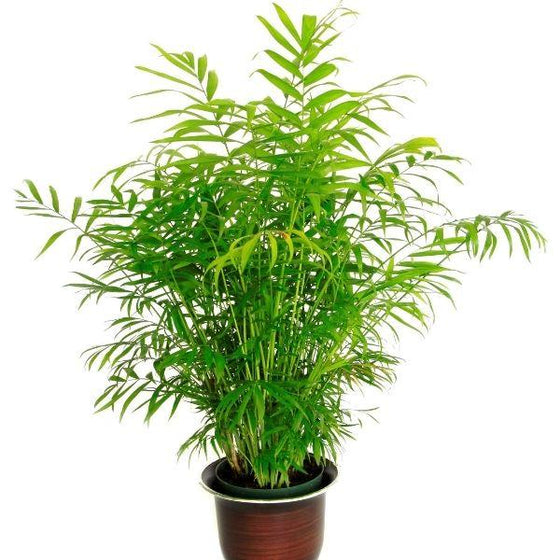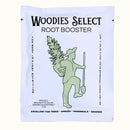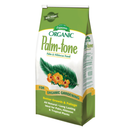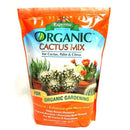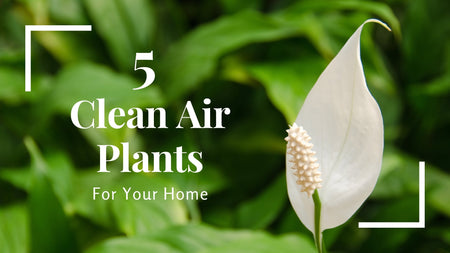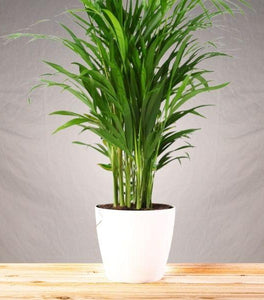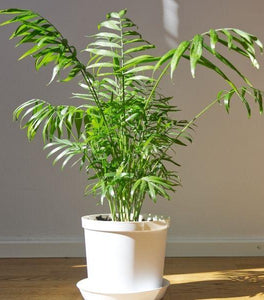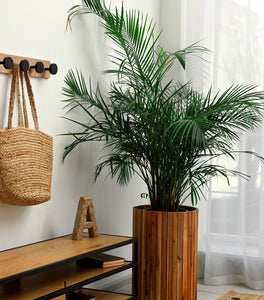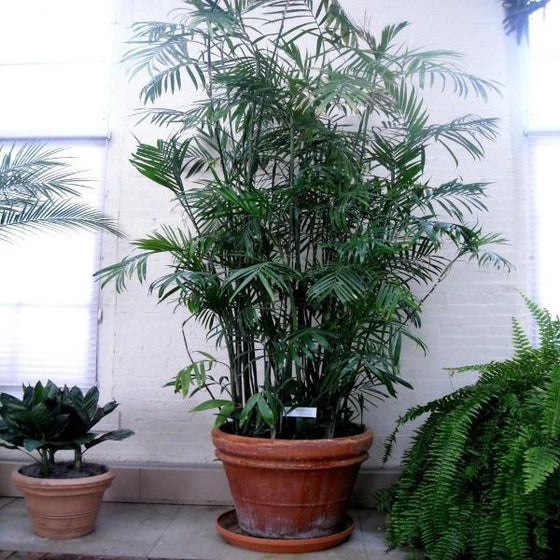
Images Depicted Range in Maturity & Container Size
Pots & Decorations Not Included Unless Otherwise Stated
Bamboo Palm: Pet-Safe, Air-Purifying Tropical for Easy Indoor Jungle Vibes
Graceful Fronds and Bamboo-Like Canes
The Bamboo Palm is a classic indoor palm featuring multiple slender, cane-like stems that mimic the appearance of clumping bamboo, topped with soft, feathery, deep-green fronds. Each stem is ringed with nodes, giving it that unmistakable “bamboo” texture while still clearly resembling a palm, which makes it a favorite for creating an instant tropical feel in living rooms, lobbies, and home offices. The overall effect is lush and airy rather than stiff—graceful arching leaves that filter light and soften the edges of your space.
Clumping, Vertical, and Room-Filling
Chamaedorea seifrizii grows as a clumping palm, sending up multiple slender trunks from the base that gradually form a dense, multi-stemmed thicket. Indoors, Bamboo Palm typically matures around 5–7 feet tall and 3–5 feet wide in a large pot, making it an excellent floor plant for adding height and soft screening without feeling bulky or overbearing. Outdoors in truly frost-free climates or in conservatories, plants can grow taller, but as a houseplant, you can expect a moderately paced, manageable growth rate that rewards you with more fronds each year rather than sudden, unmanageable size jumps.
Indirect Light, Even Moisture, and Humidity
The Bamboo Palm is naturally adapted to the understory of Central American rainforests, so it thrives in low to medium indirect light and handles the softer light of most homes and offices well. It will tolerate brighter conditions, but harsh direct sun—primarily through glass—can scorch the delicate leaflets, so think bright, filtered light near a window, not full-on blazing exposure. Give it a rich, well-draining potting mix and keep the soil evenly moist, watering when the top inch feels dry; this palm appreciates consistent moisture but resents sitting in waterlogged soil.
Because it comes from humid forests, Bamboo Palm enjoys higher humidity and steady indoor temperatures typically between about 65–80°F. It will tolerate average household humidity, but lightly misting the foliage, grouping it with other tropical plants, or using a small humidifier helps prevent the tips from browning in very dry air. With this combination of gentle light, evenly moist but draining soil, and reasonable humidity, your palm will steadily produce new canes and fronds that keep it lush and full.
Pet-Safe, Air-Purifying Focal Point
Indoors, Bamboo Palm acts like a living green room divider or backdrop, softening corners, anchoring seating areas, and adding vertical interest behind sofas and chairs. It’s widely recognized as one of the palms included in NASA’s classic clean-air research. It is often recommended for improving perceived indoor air quality by filtering common VOCs, which makes it especially appealing in bedrooms, home offices, and shared living spaces. Additionally, the Bamboo Palm is considered non-toxic to both pets and humans, providing a lush, dramatic presence that’s also friendly to cats, dogs, and children.

| Hardiness Zone: | 10–11 outdoors; grown as a container/indoor plant elsewhere |
|---|---|
| Mature Height: | Indoors typically 5–7 ft tall |
| Mature Width: | 3–5 ft wide in a large container |
| Classification: | Clumping evergreen palm; tropical houseplant |
| Sunlight: | Low to medium indirect light; tolerates bright filtered light, avoid hot direct sun |
| Bloom Time/Color | Occasional small yellowish flowers; primarily grown for foliage |
| Soil Condition: | Rich, well-draining potting mix; evenly moist but never soggy |
| Water Require: | Water when top 1" is dry; keep soil consistently lightly moist with good drainage |
| Uses: | Floor plant, soft screen, corner filler for homes, offices, lobbies, and pet-friendly spaces |
How to Care for Bamboo Palm
Before you buy a Bamboo Palm plant, make sure to read about the care instructions that are required and recommended to keep this plant healthy and thriving.

How should I plant Bamboo Palm?
Choose a sturdy container with drainage holes that’s just one or two sizes larger than the nursery pot, since Bamboo Palm prefers a comfortably snug root zone. Use a high-quality indoor potting mix enriched with organic matter and amended with a bit of perlite or fine bark to keep the mix moisture-retentive yet free-draining. Gently slide the palm from its grower pot, loosen any circling roots, and set the root ball so the existing soil line sits level with or just above the surrounding mix. Backfill around the roots, lightly firming to eliminate air pockets without compacting the soil. After planting, water thoroughly until excess moisture drains from the bottom of the pot, then let it finish draining before returning it to its saucer or decorative cachepot. Place your Bamboo Palm in low to medium indirect light—such as several feet back from an east or north window, or in a bright room where the sun is filtered by sheer curtains. Avoid placing it in harsh, direct afternoon sun that can burn the delicate leaflets, or in cold drafts near frequently opened exterior doors.
How often should I water Bamboo Palm after planting?
Right after planting, that first thorough watering settles the potting mix around the roots, but after that, the key is consistency, not frequency. Check the soil with your finger and water when the top inch feels dry to the touch; for many indoor environments, that might mean watering roughly once a week in spring and summer and somewhat less often in fall and winter. Water slowly and deeply until moisture drains out of the bottom, then discard any water that collects in a saucer so the roots aren’t left standing in it. Because Bamboo Palm dislikes both extremes—soggy soil and bone-dry mix—aim for evenly moist but never saturated. In lower light or cooler rooms, you’ll need to water less frequently, while in warm, bright conditions with dry air, you may find yourself watering a bit more often. Watch the foliage for feedback: drooping or crispy tips often signal underwatering or very low humidity, while yellowing, mushy stems usually point to overwatering and poor drainage.
When should I fertilize Bamboo Palm?
Bamboo Palm is not a heavy feeder, but it does appreciate gentle nutrition during the active growing season. From spring through early fall, use a balanced, water-soluble houseplant fertilizer at about half the recommended strength once every 4–6 weeks. Always apply fertilizer onto already moist soil rather than completely dry mix to reduce the risk of root burn, and avoid overdoing it—more fertilizer does not mean faster, healthier growth with palms. If you prefer organic options, you can top-dress the soil with a thin layer of compost or worm castings in spring and supplement with a mild organic liquid feed a few times during the growing season. Pause fertilizing in late fall and winter when growth slows and light levels drop; unused salts can build up in the soil and contribute to browning tips. A spring flush of fresh nutrients paired with brighter light will set your Bamboo Palm up for a season of strong, glossy new fronds.

When and how should I prune Bamboo Palm?
Bamboo Palm requires very little structural pruning—most of your maintenance will be simple grooming. Use clean, sharp scissors or pruners to remove yellowing, brown, or significantly damaged fronds by cutting the entire leaf stem close to the soil line or at the point where it joins the cane. If only the tips are brown but the rest of the frond is healthy, you can trim the browned portion following the natural shape of the leaflet to keep the plant looking tidy. As the plant matures and produces more canes, you can selectively remove older, declining stems at the base to encourage fresh growth and maintain a balanced shape. Do any larger shaping or dividing in spring or early summer, when the palm will recover most quickly. Regularly dusting the fronds with a soft cloth not only keeps them attractive but also makes it easier to spot early signs of pests such as spider mites or scale, which are easier to manage when caught early.



